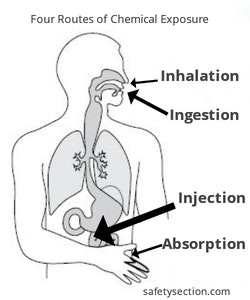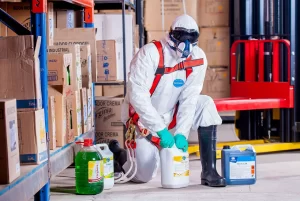The first rule of Chemical safety is…
“Know what you are working with and how to protect yourself and others”
Chemical safety is important for improving health and safety in the workplace. Reducing costs on disposal and less spending on wastewater. It also reduces costs associated with production as well as the impact on the environment.

Chemicals improve quality of life, but can also harm & kill! Therefore, we should know the hazards of chemicals and the appropriate precautions to take to work safely and avoid injury.
Why Is Chemical Safety Important?
- Improving health and safety
- Lower spending on disposal
- Lower spending on wastewater/effluent
- Benefits of reducing production costs
- Benefits from reducing the impact on the environment
More information on health and safety signs and their meanings can be found here in the article I wrote on the subject.
Types of chemical hazards
Hazardous chemicals are categorized as follows:
- Flammable or explosives – Petroleum, diesel, etc.
- Irritating or corrosive to skin, lungs, and eyes – Acid, Alkali, Paints, Fumes, etc.
- Toxic chemicals – Carbon monoxide, Hydrogen sulfide, Cyanide, etc.
- Reactive
- Biological (infectious)
- Carcinogen (cancer-causing)
- Radioactive etc.
Classification of Chemicals Based on Hazardous Nature
There are three types of chemical hazards:
- Physical Hazards
- Health Hazards
- Environmental Hazards
Physical Hazards
Flammable and combustible material, Compressed gas, Oxidizing material, Poisonous and infectious material, Corrosive material, and dangerously reactive material.
Health Hazards
Health hazards are chemicals that are harmful to your health and can cause: Short and long-term health problems.
Environmental Hazards
Hazardous to the aquatic environment. Environment Pollution (water pollution, soil pollution, air pollution).
Four Routes of Chemical Exposure and Effective Controls

Chemicals will solely enter our body by |
Effective controls |
Inhalation e.g. inhaling vapors, particles or gases |
Good ventilation, face masks |
Ingestion
e.g. swallowing residues when failing to clean hands after using chemicals and before eating |
Wash hands after use, gloves |
Absorption
e.g. through the skin or eyes |
Good ventilation, eye protection, and alternative PPE |
Injection
e.g. unintentional skin penetration by needles or alternative sharp objects |
Use a pair of tongs, and gloves, and handle things with care |
When Should Personal Protective Equipment Be Inspected?
Before deciding on the required personal protective equipment (PPE) you should assess workplaces, procedures, and worker’s behavior to understand which parts of the body are likely to be exposed to the chemicals.
The four types of clothing that may be required for skin and eyes protection are:
- Chemical protective gloves
- Coveralls
- Protective footwear
- Face or eye shields

Guidelines on Storage of Hazardous Chemicals
- Store incompatible chemicals in separate areas
- Limit the number of flammable materials to the minimum required
- Store flammable liquids in approved flammable storage lockers
- Store acids in separate flammable storage lockers
- Don’t store chemicals in a refrigerator used for food storage
- Don’t store food in refrigerators used for chemical storage
Chemical Emergency Response Plan
- Know emergency phone numbers
- Know the equipment shutdown procedure
- Ensure a safe and suitable place for fire extinguisher
- Identify and list out all possible emergency situations
- Identify the effects and impact of emergency situations
- Establish emergency response equipment
- Know proper evacuation routes and assembly areas, and
- Ensure that all staff is familiar with the arrangements in case of emergencies, through the provisions of instructions and training including regular drills.
More Information on Fire Extinguishers can be found in the articles I wrote:
- Fire Extinguisher Operating Procedure
- How To Use Fire Fighting Equipment
- How Many Fire Extinguishers Do I Need?
- 12 Best Fire Extinguisher Reviews
FIRST AID
First Aid for…
- Chemicals in the Eyes
- Chemicals on the Skin
- Chemical Inhalation
- Chemical Ingestion
First Aid for Chemicals in the Eye
- Don’t rub the eyes
- Hold eyelids open and flush with water for 15 minutes
- Be careful not to contaminate the other eye
- Seek additional medical attention
- Call emergency personnel or a physician right away
- Irrigate eyes with water for second 15 minutes if emergency personnel or physician isn’t right away available
More information on the eye wash we recommend can be found in the article I wrote here.
First Aid for Chemical Burns on Skin
- Shower the victim/flash the affected area with lukewarm water for 15 minutes, removing all contaminated clothing
- Wash the affected area with soap and water
- Remove clothing and jewelry from the burn area
- Seek additional medical attention
First Aid for Chemical Inhalation
- Remove the victim from contaminated space
- Keep victim heat in a much-reclined position with head and shoulders elevated
- Give oxygen as soon as possible
- Call emergency personnel or a physician immediately
- Move the victim to fresh air
First Aid for Chemical Ingestion
- Induce vomiting only if told to do so by poison control
- Get immediate medical attention
Chemical Hazard Control Measures
-
- Reducing chemical use
- Chemical recovery and re-use
- Replacing more-polluting chemicals with less-polluting substances
- Dosing control
- Unnecessary chemical use must be controlled
- Zero discharge of hazardous chemicals
- Improved dye fixation
- Site audit
- Risk assessment
Related Resources:
- The 5 Key Elements of a Successful Incident Action Plan
- Risk Assessment Calculation Formula
- Effective Building Safety Management System
- Classification Of Personal Protective Equipment PPE
